Cheek enhancement has become a popular cosmetic procedure aimed at rejuvenating and reshaping facial features. With advancements in medical aesthetics, there are now several techniques available to enhance the appearance of the cheeks effectively. From injectable fillers to surgical procedures, individuals seeking to enhance their cheekbones have various options to choose from.
The desire for enhanced cheekbones and facial symmetry has a long history dating back centuries. In ancient civilizations like Egypt and Greece, individuals used various methods to enhance their facial features, including the use of cosmetics, jewelry, and facial exercises. However, it wasn’t until the early 20th century that surgical techniques for cheek enhancement began to emerge.
The first documented cheek implant surgery took place in the 1950s, using materials like silicone or polyethylene. Over time, advancements in medical aesthetics led to the development of minimally invasive procedures like injectable fillers and thread lifts, offering safer and more customizable options for cheek enhancement. Today, cheek enhancement procedures continue to evolve, driven by advancements in technology and an increasing demand for natural-looking results.
In this article, we’ll explore some of the top cheek enhancement techniques used today, detailing their benefits, considerations, and potential outcomes.
Injectable Dermal Fillers:
Injectable dermal fillers are among the most common and versatile options for cheek enhancement. These fillers, typically made of hyaluronic acid or calcium hydroxylapatite, are injected beneath the skin to add volume, contour, and lift to the cheeks. The procedure is minimally invasive and offers immediate results with minimal downtime.
One of the primary advantages of dermal fillers is their ability to provide customizable results. A skilled practitioner can tailor the treatment to address specific concerns, such as volume loss, asymmetry, or sagging cheeks. Additionally, hyaluronic acid fillers stimulate collagen production, contributing to long-term improvement in skin quality and elasticity.
While dermal fillers are generally safe, temporary side effects such as bruising, swelling, or redness may occur. It’s important to choose a reputable clinic to minimize the risk of complications and get the desired results.
Fat Grafting:
Fat grafting, also known as fat transfer or autologous fat injection, is another popular method for cheek enhancement. This procedure involves harvesting fat from one area of the body, such as the abdomen or thighs, and injecting it into the cheeks to restore volume and contour.
Fat grafting uses natural tissue from the patient’s body to reduce the risk of allergic reactions or rejection. Additionally, since the injected fat contains stem cells, it can promote tissue regeneration and improve skin texture over time.
While fat grafting provides long-lasting results, with some fat cells permanently integrating into the cheeks, multiple sessions may be required to achieve the desired outcome. Furthermore, the success of fat grafting depends on the survival of transferred fat cells, which can vary from person to person.
Cheek Implants:
For individuals seeking a more permanent solution to cheek enhancement, cheek implants offer a surgical option. These implants are silicone or solid materials surgically placed over the cheekbones to enhance projection and definition.
Cheek implant surgery is typically performed under local or general anesthesia and involves making small incisions inside the mouth or along the lower eyelid. The implants are then carefully positioned and secured in place, providing immediate augmentation to the cheeks.
One of the main advantages of cheek implants is their durability, as they do not degrade over time like injectable fillers. Additionally, cheek implants can be customized in shape and size to achieve the desired aesthetic outcome.
However, cheek implant surgery carries risks associated with any surgical procedure, including infection, implant shifting, or asymmetry. It’s crucial for patients to undergo a thorough consultation with a board-certified plastic surgeon to discuss their goals, expectations, and potential complications.
Thread Lift:
Thread lift, also known as a thread lift or suture lift involves inserting dissolvable sutures or threads beneath the skin and lifting the underlying tissues to create a more youthful and defined appearance.
Thread lift offers several advantages, including minimal downtime, reduced risk of scarring, and immediate improvement in cheek contour. The procedure stimulates collagen production, further enhancing skin elasticity and firmness over time.
However, the results of thread lift procedures are temporary, lasting approximately one to two years, as the threads gradually dissolve. Additionally, thread lift may not be suitable for individuals with significant skin laxity or advanced signs of aging.
In conclusion, cheek enhancement techniques have evolved significantly, offering individuals a range of options to achieve their desired aesthetic goals. Whether seeking subtle volume enhancement or dramatic cheekbone definition, patients can choose from injectable fillers, fat grafting, cheek implants, or thread lift procedures. However, it’s essential to consult with a qualified medical professional to determine the most suitable technique based on individual anatomy, preferences, and expectations. With proper planning and execution, cheek enhancement procedures can provide natural-looking results and enhance overall facial harmony and balance.
.

